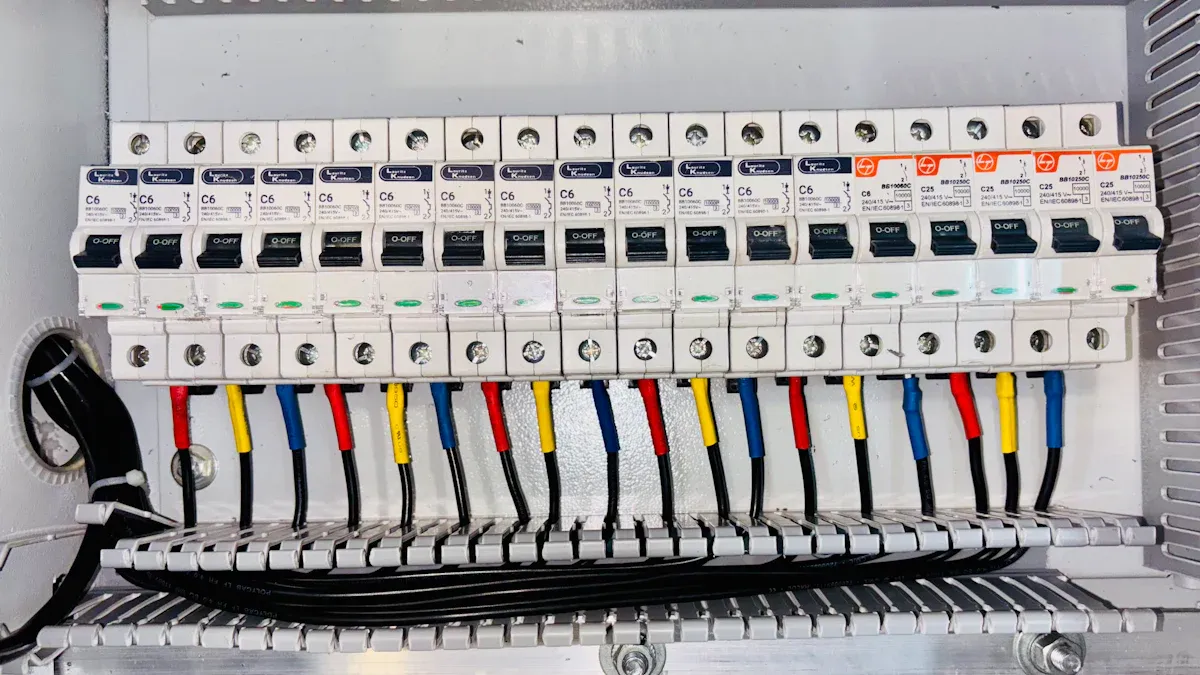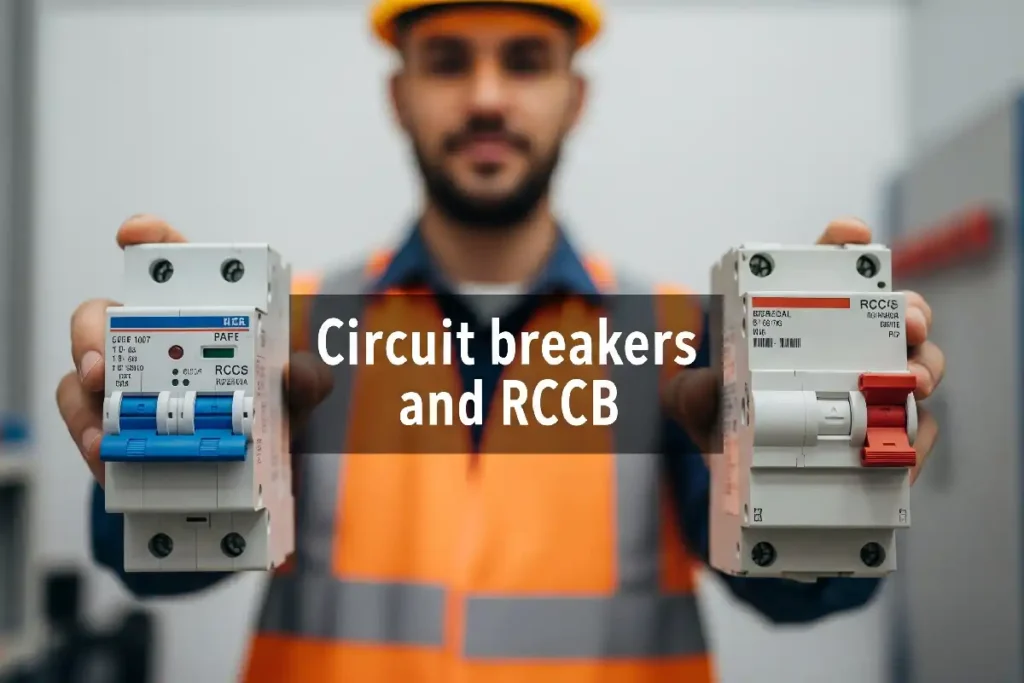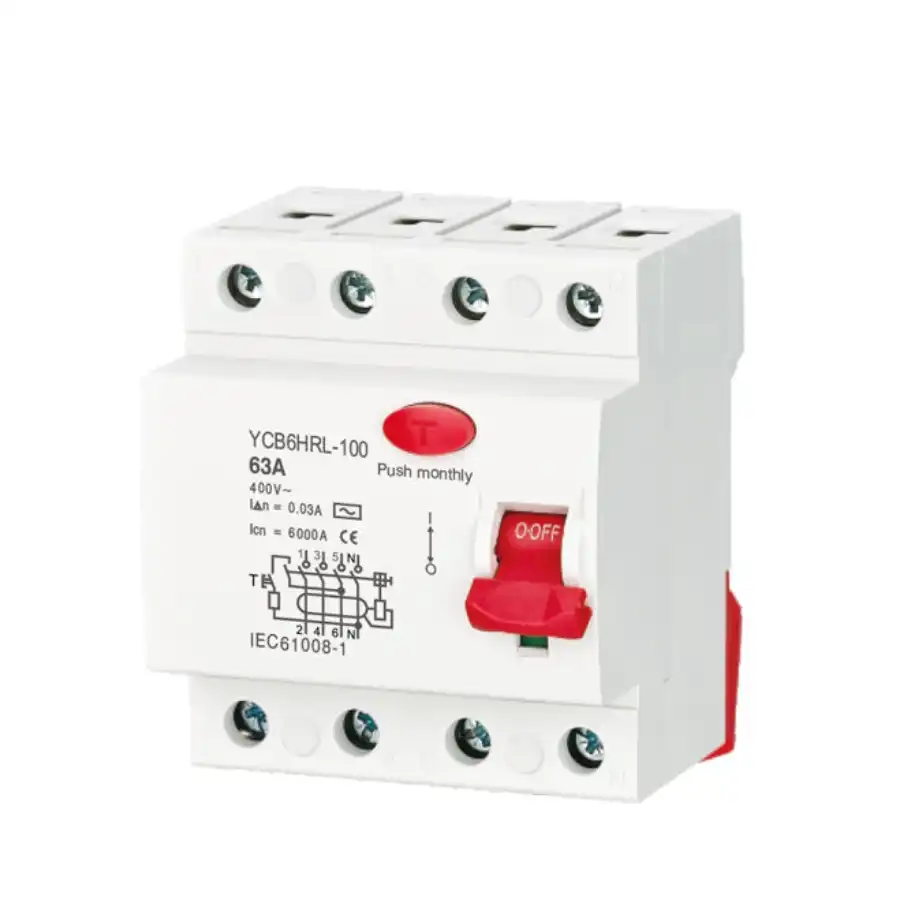You should know the difference between circuit breakers and rccbs when picking an electrical safety device. Circuit breakers and rccbs do not work in the same way. Circuit breakers keep you safe from too much current and short circuits. ELCB, also called rccb, mainly keeps you safe from electric shock. ELCB will not stop every problem, but it helps with some dangers. You use circuit breakers and rccbs together for better safety. ELCB, circuit breakers, and rccbs all protect your home in different ways. This guide shows you why each ELCB is important. ELCB can save lives, so learn what makes each ELCB special.
Key Takeaways
- Circuit breakers keep your home safe from too much current. They also stop short circuits by turning off power fast.
- RCCBs find small leaks of electricity that go to the ground. They help protect you from getting an electric shock.
- You need both circuit breakers and RCCBs for full safety. This keeps you safe from fires and shocks.
- Pick the right device for your needs. Check the current ratings and where you will put it.
- RCBOs give both types of protection in one device. They save space and make safety easier.
Circuit Breakers

What They Do
Circuit breakers help keep your electrical system safe. They stop electricity if there is too much current or a fault. When this happens, the circuit breaker trips and cuts off power. This helps prevent fires and stops damage to your devices. Circuit breakers sense danger in two ways:
- Thermal tripping: A bimetallic strip gets hot and bends when current is high. The bending makes the circuit breaker trip.
- Electromagnetic tripping: A strong magnetic field forms during a sudden surge. This field pulls a lever and trips the circuit breaker.
You can reset a circuit breaker after it trips. This is easier than changing a fuse. Circuit breakers protect homes and businesses from overloads and short circuits. They give better protection and lower the risk of fire or electric shock.
Types (MCB, MCCB)
There are two main types of circuit breakers: mcb and mccb. Each one is used for different jobs.
| Aspect | Miniature Circuit Breaker (MCB) | Molded Case Circuit Breaker (MCCB) |
|---|---|---|
| Current Rating | Up to 125A | Up to 2000A or more |
| Installation Method | Mounted on rails | Screw mounting |
| Adjustability | Fixed settings | Adjustable settings |
| Arc Extinguishing | Weaker | Stronger |
| Application Environment | Homes, small businesses | Industry, large commercial |
| Lifespan | Shorter | Longer |
You use mcb in homes and small shops. mcb is small and easy to put in. It works well for low currents. mccb is bigger and can handle more current. You use mccb in factories or big buildings. mccb lets you change settings for better protection.
Protection Scope
Circuit breakers protect against short circuits and overloads. If a short circuit happens, the circuit breaker trips fast. This stops sparks and fire. If you plug in too many things, the circuit breaker senses the overload and trips before wires get too hot. Some special circuit breakers, like GFCI and AFCI, protect you from ground faults and arc faults. This gives you strong protection from many dangers.
Remember, circuit breakers do not replace elcb. elcb gives extra safety from electric shock. You need both for full protection. mcb and mccb stop too much current and short circuits. elcb helps with shock hazards.
Tip: Always pick the right circuit breaker for your needs. Check the current rating and type before you put it in.
RCCB (Residual Current Circuit Breaker)
How RCCBs Work
RCCB helps protect your home from earth leakage. It checks the current in both live and neutral wires. The device uses a toroidal core to sense magnetic fields. Normally, the currents in these wires are equal and opposite. If earth leakage happens, some current escapes to the ground. This causes an imbalance in the wires. RCCB detects this leftover current. If the difference is higher than a set amount, usually between 5 and 30 milliamperes, RCCB trips and turns off the circuit. This happens very fast, often in 30 milliseconds. You get quick protection from electric shock and fire. RCCB is more sensitive and faster than a standard circuit breaker or elcb for this job.
Tip: Put RCCBs on all sub-circuits for better safety and easier troubleshooting.
Protection Against Electric Shock
RCCBs, also called rcds or elcbs, give strong protection from electric shock. The device watches for earth leakage and trips quickly when it finds leftover current. Standard circuit breakers like MCBs do not react to earth leakage or leftover current. RCCBs turn off the circuit in about 20 milliseconds. This lowers the chance of injury and electrical fires. RCCB keeps you safe because it reacts to even small leakage currents. The device is important for homes and workplaces where electric shock protection matters.
Limitations
You should know the good and bad sides of rccb before you pick one. RCCBs, rcds, and elcbs do not protect against overloads or short circuits. Their main job is to find earth leakage and leftover current. RCCB works well if installed right and if the device is good quality. There are different types of RCCBs, like Type AC, Type A, Type F, and Type B. Each type finds different kinds of earth leakage. Type AC only finds alternating leftover currents. Type B works with AC, pulsating DC, and pure DC currents. Basic RCCBs may not protect you from every kind of leakage current.
| Protection Aspect | RCCB Protection | Limitation Explanation |
|---|---|---|
| Overload Protection | No | RCCBs do not protect against overloads. |
| Short Circuit Protection | No | RCCBs do not protect against short circuits. |
| Earth Fault Protection | Yes | RCCBs detect earth faults well. |
| Leakage Current Protection | Yes | RCCBs find leakage currents to stop shocks. |
| Suitable for Modern Systems | Yes | RCCBs work with modern electrical systems. |
| Effective with Broken Earth | Yes | RCCBs still work if earth connection breaks. |
You should put RCCBs on all circuits for better safety and easier fault finding. The earth leakage circuit breaker, also called a residual current device or elcb, is important for leftover current protection, but it does not give full protection. You need to use RCCBs with other devices for complete safety. Knowing the good and bad sides of rccb helps you choose the best one for your electrical system.
Circuit Breakers and RCCBs: Main Differences
Knowing how circuit breakers and RCCBs are different helps you pick the right one. Each device does a special job. You should learn what each device does and where to use it. This part shows how they protect, where they work, and compares them.
Protection Mechanisms
A circuit breaker, like an MCB or MCCB, stops too much current and short circuits. It senses when the current is too high or if there is a fault. It trips by using heat or magnets. This stops electricity and keeps wires and devices safe.
An RCCB, also called a residual current circuit breaker or ELCB, works in another way. It checks for earth leakage by looking at the balance between live and neutral wires. If it finds a difference, even a small one, it trips fast. This keeps you safe from electric shock. RCCB does not care about overloads or short circuits. It only looks for current leaking to the ground.
Here is how these devices work:
- MCBs and MCCBs trip with heat or magnets when current is too high.
- RCCBs use a special transformer to sense current leaking to the ground.
- RCCBs have a test button for checking. MCBs need outside tools to test.
Note: ELCBs and RCCBs do not take the place of circuit breakers. You need both for full safety.
Applications
You see circuit breakers in homes, offices, and factories. They protect wires and equipment from too much current and short circuits. MCBs are good for homes and small shops. MCCBs are used in big buildings and factories with higher currents.
RCCBs, or ELCBs, protect people from electric shock. You use them in places with water or metal, like bathrooms, kitchens, or workshops. In work areas, RCCBs keep workers safe when using power tools or working near wires. You also find RCCBs in schools, hospitals, and public places. They trip quickly when they sense earth leakage, so they are important for safety.
RCDs, another name for RCCBs, are needed by many safety rules. You must use them in wet places and outside circuits. They help stop fires from bad wiring or broken appliances.
Tip: Always use an RCCB with a circuit breaker. This gives you both overcurrent and earth leakage protection.
Comparison Table
You can see the main differences between circuit breakers and RCCBs in this table. It helps you know what each device does and where to use it.
| Aspect | Circuit Breaker (MCB/MCCB) | RCCB (ELCB/RCD) |
|---|---|---|
| Protection Scope | Overcurrent (overload, short circuit) | Earth leakage, electric shock |
| Operating Principle | Trips on high current using heat or magnets | Trips on current leaking to ground |
| Sensitivity | Rated by current (like 6A, 32A) | Rated by leakage (like 30mA, 100mA) |
| Response Time | Microseconds to seconds | Milliseconds |
| Typical Use Cases | Homes, offices, factories | Wet places, outside circuits, high shock risk |
| Maintenance | Needs checks for age, heat, or not tripping | Needs testing with built-in test button |
| Overcurrent Protection | Yes | No |
| Earth Leakage Protection | No | Yes |
| Residual Current Protection | No | Yes |
| Installation | Simple, low cost | Needs extra wiring, higher cost |
You can also look at how fast each type trips. The chart below shows this. RCCBs trip faster when they find earth leakage.
Key Points to Remember
- Circuit breakers stop too much current and short circuits. RCCBs stop earth leakage and electric shock.
- You need both devices for full safety. One does not do the job of the other.
- RCDs, ELCBs, and RCCBs all look for current leaking to the ground.
- MCBs and MCCBs do not sense earth leakage. They only trip for too much current.
- Using both devices keeps your home or business safe.
⚡ Myth: RCCBs protect against overloads and short circuits.
Fact: Only circuit breakers like MCBs and MCCBs do that. RCCBs only trip for earth leakage.
⚡ Myth: Putting an RCCB on every circuit always gives better safety.
Fact: Too many RCCBs can cause problems. You need to match devices and sometimes use a residual current circuit breaker with overcurrent protection (RCBO) for the best result.
If you want both overcurrent and earth leakage protection in one device, you can use a residual current circuit breaker with overcurrent protection. This device does what an MCB and an RCCB do together.
Choosing the Right Device
Factors to Consider
When you select between a circuit breaker, rccb, or rcbo, you need to look at several important points. This guide helps you understand what to check:
- Decide what type of protection you need. Circuit breakers stop overloads and short circuits. rccb, elcb, and rcd detect leakage currents to prevent electric shocks and fires.
- Check the sensitivity level. For homes, 30mA rcd or rccb is common for human protection. In factories, you might need 300mA for fire safety.
- Look at where you will install the device. Wet or dusty places need devices that can handle moisture and dirt.
- Make sure the voltage rating matches your system. Most rccb and elcb devices work from 230V to 415V.
- Always follow local safety measures and standards like IEC 61008 or IEC 61009.
- Think about the type of load. Simple home appliances need basic rcd or elcb. Complex machines may need advanced types.
- For full protection, rcbo combines both rccb and circuit breaker features.
Tip: Always use the right device for your needs. This keeps your home or business safe.
When to Use Circuit Breakers, RCCBs, or Both
You should know what each device does before you choose. Here is a quick guide:
- Use circuit breakers (like mcb or mccb) to protect against overloads and short circuits.
- Use rccb, elcb, or rcd to protect against electric shock and earth faults.
- For the best safety measures, use both together. Circuit breakers and rccb or elcb cover all risks.
- In homes, both devices work together to protect people and property.
- If you already have a circuit breaker, you can add an rccb or elcb for extra protection.
Note: Only using one device leaves gaps in your safety. Both together give full coverage.
RCBOs as a Combined Solution
An rcbo gives you the benefits of both a circuit breaker and an rccb or elcb. Here is what makes rcbo a smart choice:
- rcbo detects leakage currents and stops overloads or short circuits.
- You save space in your panel because rcbo combines two devices in one.
- rcbo is great for homes, small businesses, and places where space is tight.
- rcbo makes troubleshooting easy. Each rcbo protects one circuit, so you find problems faster.
- Even though rcbo costs more at first, it saves money on wiring and maintenance later.
If you want to know how to choose and install a residual current circuit breaker, always check your needs, follow safety measures, and use this guide for help.
It is important to know how circuit breakers and rcds are not the same. Circuit breakers stop too much current and short circuits. rcds and elcb devices find leakage currents. This helps protect you from electric shock and fire. If you use both rcd and elcb units in your panel, you get full safety for your home and yourself.
- Pick rcd and elcb types that match your home’s needs. Look at how sensitive they are and their current rating.
- Test each rcd and elcb often to be sure they work right.
- Many places make it a rule to install rcd and elcb for safety.
- Using rcd, elcb, and circuit breakers together can stop over half of electrical fires.
Always have a trained electrician choose and put in rcd, elcb, and circuit breakers for your system.
FAQ
What is the main job of a circuit breaker?
A circuit breaker protects your wiring and devices from too much current or short circuits. It trips and cuts off power when it senses danger. This helps prevent fires and damage.
What does an RCCB do that a circuit breaker cannot?
An RCCB detects earth leakage currents. It trips when it finds current leaking to the ground. This protects you from electric shock, which a circuit breaker cannot do.
What should you check before choosing between a circuit breaker and an RCCB?
You should check what type of protection you need. Circuit breakers stop overloads and short circuits. RCCBs protect against electric shock from earth leakage. Sometimes, you need both for full safety.
What is an RCBO?
An RCBO combines the features of a circuit breaker and an RCCB. It protects against overloads, short circuits, and earth leakage. You get both types of protection in one device.
What happens if you only use a circuit breaker without an RCCB?
If you only use a circuit breaker, you do not get protection from electric shock caused by earth leakage. You risk injury or fire from hidden faults. Always use both for complete safety.
See also
Revealing the Differences between ELCB and RCCB
How to tell the difference between ELCB and RCCB fast
What Are Residual Current Circuit Breakers and How Do They Work
Top 8 Residual Current Circuit Breaker Brands for Home Safety
How to Resolve RCCB Tripping Problems at Home




